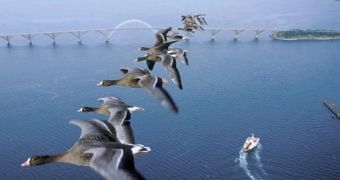This is particularly difficult for human pilots master formation flight: it takes years of practicing. But for migratory birds that's piece of cake. 65 % of the birds species do migrate.
The way birds migrate varies a lot: some will do it alone (like the cuckoo), others in pairs, while others in large flocks. The little song birds usually form swarms but the larger birds migrate in well defined formations, the individual from the front of the line "splitting" the air and after a while passing in the rear for rest of the journey.
The reason why geese, ducks, swans, pelicans or cranes fly in a V-shape has puzzled researchers for long. There were some theories but now a team at the Federal University of Rio de Janeiro, Brazil, has made a computer model checking two different theories.
The first and most accepted is that the flight formation plays an aerodynamic role: each individual makes an upwash behind its wing tips offering to those behind it an extra lift.
The other theory sustains that the flight in a slightly skewed position relative to the previous bird permits an unimpaired vision.
Researchers Valmir Barbosa and Andre Nathan developed the computer models of flocks made of 15 to 35 individuals. Each individual could detect the closest bird and to locate itself so that its visual field was not impaired but also readjust its location to take advantage of aerodynamics forces delivered by front individuals.
"The results showed that both theories hold true. Previous computer models that did not take both into account were unable to reproduce V-formations, but we have found that these formations occur regardless of how the birds are positioned initially", said Barbosa.
The researchers also put the computerized birds into other natural patterns, like W-formations. "This is an appealing instance of how complexity emerges from simple rules."

 14 DAY TRIAL //
14 DAY TRIAL //